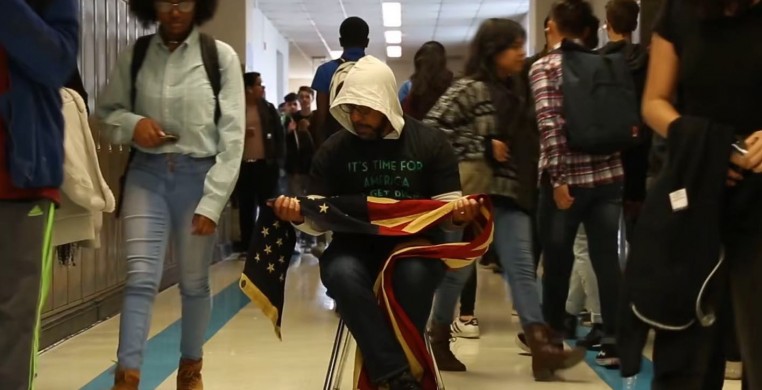Editor's note: Last March, See Chicago Dance kicked off Screendance Club, a bi-monthly dance film watch party and guided discussion. While I personally haven't been enthusiastic about digital dance, Screendance Club was a perpetual joy throughout the year. The curators each wrote beautiful responses about their experiences with the films they chose, all published here on See Chicago Dance. In addition, SCD writer-at-large Gregory King shares his reflections on the series as a whole in a two-part essay. The first part is below. Enjoy!
What do the stories we tell say about us?
When should we shed our masks and produce art that unshackles us from oppression?
For six months between March and September, See Chicago Dance hosted its inaugural Screendance Club: a series of “radically casual” watch parties designed to engage dancers, choreographers and art lovers in the perspectives, processes and the products of dance films. And as 2020 gave us the onset of COVID-19 — making it easy to normalize the frequency of digital interactions — and a summer charged with protesting racial injustice, artists leaned into what the pandemic, socio-political issues and the digital space offered: the ingredients to create art and the possibilities of reaching global audience. See Chicago Dance provided a platform where the manifestations of artists’ actualities during a pandemic and a time of social unrest could be shared. The six-part series proffered variants on themes that emerged from seclusion, inequity, protest, unease, insecurity, fear and trepidation. Each film centered stories that grew wings and flew, providing a chance for all who witnessed to consider different realities as we clung to optimism, individualism and self-determination from wherever we called home.
The space See Chicago Dance created served as a communal call for discourse. And in that virtual space, participants gave themselves permission to embrace and celebrate dance films, their range and their impact.
Filmmakers Meghan Frederick, C. Kemal Nance, Antoine Hunter, Andy Hines, Cecil McDonald, and Lorin Sookool were storytelling performers, dancers, artists, embodied researchers, activists and educators. They were African, American, old, young, Black, White, queer, gay, gender non-conforming and disabled, sharing their creative research with a community of dance lovers.
All were generous and their generosity was a gift.
I was humbled to have facilitated the series’ first conversation on March 24, 2021 with Dr. Kemal C. Nance who was the featured artist in the inaugural session. Nance’s “Deez Nuts!: Black Bodies Dancing Defiance,” showcased Black male dancing bodies acting and moving, dialoguing with spaces in Jamaica, the U.S. and the United Kingdom. They told stories seeped in social, cultural and political empowerment. Stories of fear, fetishization, confidence, conflict, spirituality and sadness. Dancers Danzel Stout, Gavin Hart and Callum Sterling told stories of self-love, bullying and dancing defiance as we watched their bold Black bodies collectively disrupt normalcy generated by Eurocentrism. Their insertions were imperative to the interrogation of gendered Blackness, the performance of sexuality and manipulating archetypes. The film demonstrated how performance platforms can be political sites where race, culture and gender are put on display to question or legitimize certain forms of social life. Black movers unreservedly engaged with autoethnography to embody types of Blackness that are outside the purview of white gaze. Employing the politics of our lived experiences to move beyond white descriptors of Blackness in performance, “Deez Nut! Black Bodies Dancing Defiance” allowed an engagement that encouraged upsetting that white gaze in order to shift the paradigm toward augmenting Black visibility on stage and screen.
Directed and performed by Cecil McDonald, Jr., “Pieta for America” was the third in the series and opened with McDonald sitting in the corridors of Senn High School on Chicago’s North Side. This may have seemed inconsequential to the film’s storyline, but it quickly became evident that the space was a representation of many narratives. McDonald chose one of the most culturally diverse schools in Chicago as his focused environment to demonstrate a Black man performing silent, quiet protest. As students meandered along the passages moving from class to class, some ignored McDonald while others questioned his objectives. Some laughed, while others did double takes, being dismissive as teenagers tend to do.
Sitting amidst chaos and draped in the American flag, which he held similarly to the way Mary holds the body of Jesus in Michelangelo’s “Pieta,” McDonald, a Black man, wore a despondency to which I, another Black man, could relate. And although Blackness is not monolithic, there was a silent hope for justice and equity.
There on the screen was a Black man holding what represents America and its pronouncements of liberty. And in a year of racial turmoil, protesting the violent killings of countless Black men and women, including George Floyd and Breonna Taylor, the film harnessed the realities of the many Black lives that may never taste the sweetness of freedom or justice. McDonald created a piece that was quiet in its delivery but loud in its reflective tones. For me, a Black man, “Pieta for America” offered the beauty of emancipation, legitimacy, and rest.
I cogitate on these two films in part one of my Screendance Club reflection as both films offered an engagement that encouraged upsetting the white gaze.
Early in this reflection, I asked, “When should we shed our masks and produce art that unshackles us from oppression?”
What if the answer is now?


